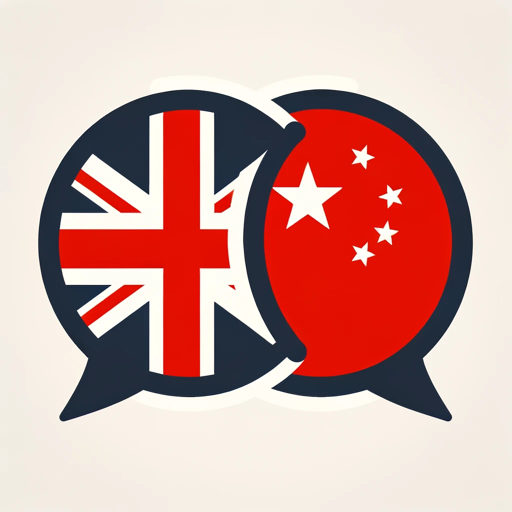Translate to Chinese-Accurate Chinese Translation Tool
AI-Powered Translations with Contextual Precision
Auto-translates any language to Chinese. 自动翻译任何语言到中文。
Type or paste in any human language
Translate to proper Chinese
Related Tools
中文paraphrase

中文写作专家
职业写手精心调试模型,写出的内容更像人类,专业,专注,值得信赖

Chinese 智译
无需说明,自动在中文和其他语言间互译,支持翻译代码注释、文言文、文档文件以及图片。No need for explanations, automatically translate between Chinese and other languages, support translation of code comments, classical Chinese, document files, and images.

中文 GPT
GPT 官方中文版本

Chinese Translator
Bilingual English/Chinese translator with Pinyin support. Visit https://translate.mom for video translations! Created by https://x.com/montakaoh

日中翻译
输入中文自动翻译为日语,输入日语自动翻译为中文
20.0 / 5 (200 votes)
Introduction to Translate to Chinese
Translate to Chinese is a specialized service designed to accurately and contextually translate text from various languages into Chinese. The primary focus is on preserving the meaning, tone, and nuances of the original content. It excels in handling a wide range of texts, from informal conversations to technical documents, ensuring that the translation is both culturally and linguistically appropriate. The service is built to adapt to different contexts, providing translations that are sensitive to the intended audience. For instance, translating a casual chat would involve informal language, while translating a business document would maintain a formal tone. This versatility makes it useful across different scenarios, whether for personal use, business communication, or academic purposes.

Main Functions of Translate to Chinese
Contextual Translation
Example
Translating a technical manual from English to Chinese, ensuring that industry-specific terms are correctly translated while maintaining the original document’s structure.
Scenario
A company looking to expand its product into the Chinese market needs its technical documentation translated. Translate to Chinese handles the translation with a focus on industry jargon and technical accuracy, ensuring the translated document is as functional and clear as the original.
Tone and Style Adaptation
Example
Translating a casual conversation from French to Chinese, preserving the informal tone and friendly expressions used between friends.
Scenario
An individual wishes to communicate with a Chinese friend in their native language, using a casual and friendly tone. Translate to Chinese ensures that the message feels natural and maintains the warmth of the original conversation.
Cultural Sensitivity
Example
Translating a marketing campaign slogan from Spanish to Chinese, ensuring that the message resonates with Chinese cultural values and avoids any potential cultural misunderstandings.
Scenario
A global brand launching a new product in China requires a marketing slogan that appeals to Chinese consumers. Translate to Chinese modifies the translation to align with cultural norms and values, ensuring the campaign is well-received by the target audience.
Ideal Users of Translate to Chinese
Businesses Expanding into the Chinese Market
Companies looking to enter or grow in the Chinese market benefit greatly from this service. Whether they need marketing materials, legal documents, or product information translated, Translate to Chinese ensures that these materials are not only accurately translated but also culturally appropriate, helping businesses connect with Chinese consumers more effectively.
Individuals Seeking to Improve Communication with Chinese Speakers
Students, travelers, or expatriates who want to communicate more effectively with Chinese speakers find this service invaluable. Whether for personal relationships, academic purposes, or daily interactions, Translate to Chinese provides translations that help bridge language gaps and foster better understanding.

How to Use Translate to Chinese
Step 1
Visit aichatonline.org for a free trial, no login required, and you don't need ChatGPT Plus.
Step 2
Input or paste the text you want translated into the designated box. Ensure your text is clear and contextually complete for the best translation accuracy.
Step 3
Select the translation mode—whether formal, conversational, or technical—based on the tone you need for your text.
Step 4
Click 'Translate' and review the translated output, paying attention to the context and style. Adjust your original text if needed for more precise results.
Step 5
Explore additional options like preserving formatting, saving the translation, or sharing it directly from the tool.
Try other advanced and practical GPTs
Optimal Instructions Builder
Create custom GPTs with AI power

SmartGPT
Unlock complex problem-solving with AI.

SOP Writer Pro
AI-powered SOP creation with diagrams

Workshop Builder
AI-powered tool for dynamic workshops

GitHubs Search
AI-powered GitHub repository discovery.

Geology Guide
AI-powered geological knowledge at your fingertips.

APA7 GPT
AI-Powered Assistance for APA 7 Compliance

Paraphrase Pro
AI-driven paraphrasing for clear communication.
Ad Creator
AI-powered creativity for unique ads.

AutoHotKey Script Helper
Streamline Your Automation with AI-Powered Scripting

Magento GPT
AI-Powered Magento Development Assistant

Semantic Content Explorer For SEO
AI-powered semantic content optimization.

- Creative Writing
- Business Communication
- Technical Documents
- Everyday Conversations
- Cultural Expressions
Common Questions about Translate to Chinese
What types of texts can Translate to Chinese handle?
Translate to Chinese can manage a wide range of texts, including casual conversations, business communications, technical documents, and even creative writing, while preserving the original tone and context.
Does this tool support translating idiomatic expressions accurately?
Yes, the tool is designed to recognize and accurately translate idioms and culturally specific expressions, ensuring the translation remains contextually relevant and natural in Chinese.
How does Translate to Chinese maintain translation accuracy for complex or specialized content?
The tool leverages AI to adapt to different contexts, ensuring that complex terms, industry jargon, and specialized vocabulary are translated correctly. Users can further refine results by providing additional context.
Can the tool handle different Chinese dialects?
The default output is in Standard Mandarin, but users can specify a preference for regional variations like Cantonese. However, fine-tuning for specific dialects may require user input or additional clarification.
How can I ensure the translation remains formal or informal as needed?
You can choose between different translation styles, including formal, conversational, or technical modes, to match the tone and register required for your text.